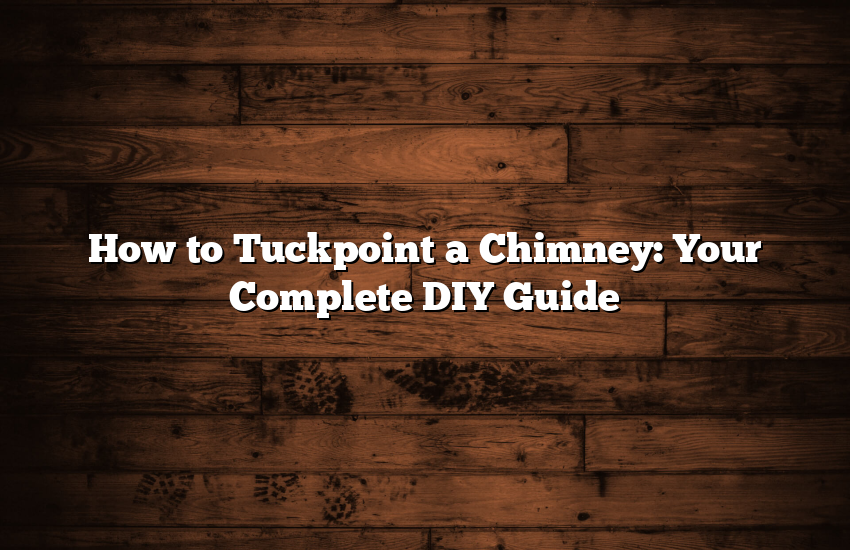
If you’re wondering how to tuckpoint a chimney, you’ve come to the right place. Tuckpointing, a critical aspect of chimney maintenance, involves the repair and replacement of mortar between bricks. This guide is designed to walk you through the tuckpointing process, ensuring your chimney remains in top condition for years to come.
Table of Contents
Understanding Tuckpointing
What is Tuckpointing?
Tuckpointing, central to maintaining the structural integrity of your chimney, is the process of removing old, deteriorating mortar and replacing it with new mortar. This technique not only strengthens the chimney but also prevents potential water damage.
The Benefits of Tuckpointing Your Chimney
- Water Damage Prevention: Proper tuckpointing seals the chimney, protecting it from water intrusion.
- Structural Stability: Reinforcing the mortar joints helps maintain the chimney’s strength.
- Aesthetic Appeal: A freshly tuckpointed chimney enhances the look of your home.
Identifying When to Tuckpoint
Recognizing the Signs:
- Look for crumbling or missing mortar.
- Noticeable cracks or gaps in the joints.
- Signs of wear and erosion in the mortar.
Preparing for Tuckpointing
- Safety Measures: Ensure you have safety gear like gloves, goggles, and a secure ladder.
- Tools and Materials: Gather the necessary tools, such as chisels, trowels, and the right mortar mix.
The Tuckpointing Process
- Removing Damaged Mortar: Carefully chisel out the old mortar, avoiding damage to the bricks.
- Mixing and Applying New Mortar: Mix the mortar to the correct consistency and apply it to the joints with precision.
- Finishing and Cleaning: Smooth the mortar and clean off any excess for a neat finish.
Maintaining Your Tuckpointed Chimney
Regular inspections and immediate repairs of minor damages are crucial in extending the lifespan of your tuckpointing work.
Common Tuckpointing Challenges and Solutions
- Matching the Mortar: The new mortar should match the old in color, texture, and strength.
- Weather Considerations: Ideal tuckpointing conditions are dry and mild; avoid extreme temperatures.
Conclusion:
Knowing how to tuckpoint a chimney is an invaluable skill for any homeowner. This comprehensive guide provides all the information you need to successfully undertake this important maintenance task. Regular tuckpointing not only ensures the structural integrity of your chimney but also enhances its appearance, contributing to the overall value and safety of your home. Whether you opt for a DIY approach or professional assistance, the key is to regularly monitor and maintain your chimney to enjoy its warmth and benefits for years.
FAQs About Tuckpointing a Chimney
Q: How often should I tuckpoint my chimney?
A: Tuckpointing frequency depends on various factors, including climate, mortar quality, and chimney usage. In general, it’s recommended every 20-30 years. However, an annual inspection is crucial to assess your chimney’s condition and determine if tuckpointing is needed sooner. Severe weather conditions and visible deterioration may also prompt more frequent tuckpointing.
Q: Can I tuckpoint my chimney myself, or should I hire a professional?
A: Tuckpointing is a skilled task that requires precision and knowledge of mortar types, proportions, and techniques. While some homeowners with masonry experience may attempt a DIY approach for small projects, it’s advisable to hire a professional for larger or complex chimneys. Professionals have the expertise to match mortar correctly, ensuring structural integrity and visual consistency. They also have the necessary safety equipment and experience working at heights.
Q: What is the best season for tuckpointing?
A: The ideal tuckpointing season is during mild, dry weather. Spring and fall are generally the best times to undertake this task. Extreme temperatures, such as freezing cold or scorching heat, can affect mortar curing and compromise the quality of the tuckpointing. Avoid rainy or excessively humid conditions, as they can hinder mortar’s drying and bonding process.
Q: How long does tuckpointing last?
A: When tuckpointing is performed correctly using quality materials, it can last for several decades. However, the longevity also depends on environmental factors, exposure to harsh weather, and maintenance. Regular inspections and prompt repairs of minor issues can extend the life of the tuckpointing significantly. Annual chimney maintenance is essential to identify any deterioration and address it promptly.
Q: Is tuckpointing an expensive process?
A: The cost of tuckpointing varies based on several factors, including the chimney’s size, condition, accessibility, and local labor rates. While it’s an investment in your home’s longevity and safety, it’s essential to get quotes from reputable professionals for accurate pricing. Keep in mind that delaying tuckpointing due to cost concerns can lead to more extensive and costly chimney repairs in the future. It’s a wise investment in preserving your home’s structural integrity and appearance.


